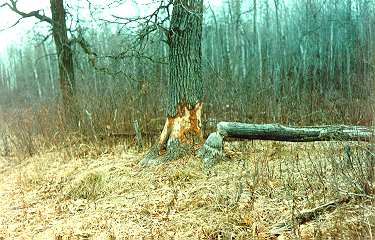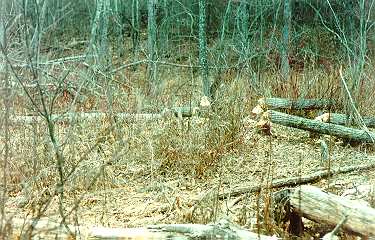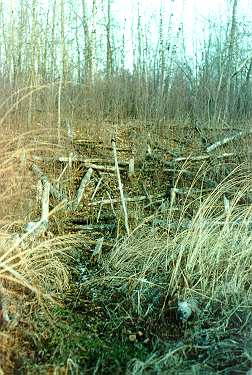
|
On this page, we will go there, proceeding from the bridge northward. A close-up of oak twins (both more than 20 cm in diameter) in a place quite close to the bridge. One of them already cut down by beavers, the other one still standing, but its prospects are also bleak. (Nov. 12) |
|---|
| Twelve days later, I found the other one lying on the ground, too. (Nov. 24) |

|
|---|

|
A few meters farther on (near the granite rock protruding into the river - see the map), the beavers started to gnaw at an oak of about half a meter in diameter. No more gnawing occurred on this tree before the start of the winter. A much smaller oak tree cut some years ago is lying next by. It seems that if beavers do not manage to process the felled trees before the winter, they are not interested in them any more in the coming years. The bark of such trees that were allowed to dry out must not be tasty (and nutritious) enough. (Nov. 24) |
|---|
| A close-up of a few more gnawed trees. Various layers of exposed bark, the yellow-white core of trees, colourful lichens on the undisturbed bark, and the white snow in the background, create together quite a nice colour scheme. (Nov. 12) |

|
|---|

|
Freshly cut trees on an old beaver clearing. (Nov. 24) |
|---|
| A similar scene farther to the north. (Nov. 24) |

|
|---|

|
Trees cut by beavers mostly in the preceding years at a place already quite close to the beaver lodge (see the next page). (Nov. 17) |
|---|
|
One of the old beaver trails ending among trees cut mostly long time ago. (Nov. 27)
Compared to the European forests cultivated for centuries, this beaver forest looks very messy. Actually it is much easier to walk through it than through other Canadian wooded areas not taken care of by beavers, i.e., through a vast majority of all Canadian (near)virgin forests. There you will usually find a difficult to penetrate tangle of fallen decaying trees that died down naturally. Also here by the river a similar forest starts some 50 m from the river bank - it is that dark wall of trees in the background of most pictures on this page. Beavers are, besides people, perhaps the only living beings who can make long-lasting changes to their habitat. In this case to a strip of forest along the river. Beavers living on creeks (see two pages ahead) change their habitat even more, often permanently. |

|
|---|